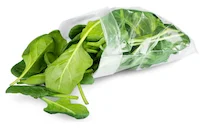- Home
- How to Dehydrate Vegetables
- How to Dehydrate Spinach
How to Dehydrate Spinach
(and Make Powder, Too!)

Susan Gast, Author
Blogger at Easy Food Dehydrating | A New Sober You | Bored Boomers | Beesville Books
So you want to know how to dehydrate spinach... keep reading!
The best and easiest way of dehydrating spinach is to use an electric dehydrator or dry the leaves in a regular oven. Both "how-to" methods are covered on this page.

Not only does dehydrating spinach lengthen its shelf life, but you can also create nutritious spinach powder for use in smoothies and other recipes!
What’s Inside Spinach? (Vitamins, Minerals & Antioxidants!)
VITAMINS: Vitamin A, and Vitamin C. It also contains Vitamin K1 and is packed with Folate.
MINERALS: Calcium, although the oxalic acid it contains can inhibit calcium absorption. But don't let that put you off as spinach is a great source of Potassium and Magnesium, along with dietary fiber.
This green leafy veggie is loaded with antioxidants such as Lutein, Zeaxanthin, and Beta-Carotene.
Tools You’ll Need to Dehydrate Spinach the Easy Way
No matter what method you choose for dehydrating spinach, a few crucial tools are needed. First, you'll need an electric dehydrator or an oven.
To me, a dehydrator is best because it allows a more precise temperature control to make sure your spinach doesn’t get too hot.
You’ll need baking sheets (for the oven method) or dehydrator trays when using a dehydrator!
Next, have a colander handy for washing the spinach, and finally, an air-tight container or bag for storing the dehydrated spinach such as an airtight container like a Mason jar or food vacuum-sealer bags that are made purposely for storing dehydrated foods.
How to Dehydrate Spinach Like a Pro (Step-by-Step)
Prepping Spinach
Spinach Prep: Rinse it under the kitchen faucet in a colander in the sink using cold water to get rid of any grit, soil, or bugs.
If you’re wondering how to dry spinach after washing, use a salad spinner. If you don't have one of those handy salad spinners, pat the leaves dry - gently - with a paper towel or two.
Optional: Pre-Treating Spinach to Retain Nutrients
Before dehydrating your spinach, you might want to consider blanching it. Blanching (read more here) can help retain the color and some of the spinach's nutrients, but this step is optional.
If you do decide to blanch the spinach, cool it down quickly in an ice water bath to stop the cooking process. Thoroughly dry it with paper towels before starting the dehydration process. Dehydrators like towel-dried leaves!
Next up: How to dehydrate spinach in a food dehydrator or an oven is coming up next.
How to Dehydrate Spinach in a Food Dehydrator
First up is using a dehydrator, which is the best way in my humble opinion.
Why? Because a dehydrator gives you better, precise temperature control (vs the oven-drying method).
- Rinse fresh spinach with cold water in a colander to remove dirt and any bugs.
- Arrange on your food dehydrator trays, making sure the spinach leaves don't overlap.
- Turn on your food dehydrator and set the temperature between 125°F and 135°F (or per your food dehydrator's instructions).
- Dehydrated spinach will be crisp and break easily in your fingers when fully dried.
- Drying time: between 2-4 hours. The difference in time is due to a few factors: the size of the leaves, and the thicker stems from large spinach leaves.
- Please remember to rotate your trays for even drying.
Try not to rush the drying process.
💡 Tip: Outside the U.S.? Most dehydrating temps here are listed in Fahrenheit — use our quick converter to see the Celsius equivalent for your machine.
How to Dehydrate Spinach in An Oven
Here's how to dehydrate spinach in the oven If you don’t own a dehydrator. You can use your regular stove oven. Spread the prepped spinach leaves on a baking sheet lined with parchment paper, making sure the leaves don’t overlap. Place the baking sheet in the oven.

The challenge with dehydrating spinach in an oven lies in temperature management. You need to set your oven to the lowest temperature setting possible, ideally not above 200°F.
💡 Tip: Outside the U.S.? Most dehydrating temps here are listed in Fahrenheit — use our quick converter to see the Celsius equivalent for your machine.
It's quite hard to do as oven temperatures become inconsistent with the oven door ajar (as mentioned in the tips, below)... and too high of a temperature may cook the spinach instead of dehydrating it.
Drying spinach this way takes about 2 to 3 hours, but keep a watchful eye so it doesn't shrivel up to nothing!
Oven Drying Tips: Avoid Burnt or Soggy Spinach!
A useful tip when dehydrating spinach in the oven is to keep the oven door slightly open, using the handle of a wooden spoon to create a gap. This allows cooler air to get in the oven and stops the oven from getting too hot, plus it allows the moisture to escape.
Also, remember that temperatures can vary within an oven, so rotating the baking sheets certainly helps to promote even drying.
Why You Should Always Let Spinach Cool Before Storing
Whichever method you choose to dehydrate your raw spinach, allowing the dehydrated spinach to cool down to room temperature is important, as with any dehydrated fruit or vegetable.
Attempting to store spinach that is still warm leads to condensation in the storage container which can lead to mold growth. And that's where oxygen absorbers come in. More on those coming up.
Plan to let the spinach cool for approximately 20 to 30 minutes after the dehydration process.
Why Dehydrating Spinach Is Totally Worth It

Before we tackle how to make dried spinach, some of you may be wondering: why do it?
Fresh spinach is widely available in our grocery stores so what's the point of drying it?
The main point is to give your spinach a longer shelf life. When dried, it's easy to add to recipes such as smoothies and soups, or dishes where you don't usually use fresh spinach.
Another reason is if it's out of season - if you're not lucky enough to live in prime growing areas such as California and the Pacific Northwest.
It's also a super way of using up the fresh spinach before it turns bad.
Picking the Perfect Spinach: What to Look For
The quality of your dehydrated spinach starts from the moment you pick or buy your fresh spinach.
Inspect spinach carefully. It should be vibrant and free of any yellow, wilting, or damaged leaves.
Fresh, organic spinach provides the best taste and nutrient profile.
Baby vs. Regular Spinach—Which Is Better for Dehydrating?
There are a few differences between dehydrating baby spinach and regular spinach:
- Leaf size - Baby spinach leaves are much smaller and more tender than regular spinach leaves. This means they dry faster and more evenly.
- Nutrient content - Baby spinach is typically harvested earlier than regular spinach so it may have slightly higher nutrient levels, especially Folate. However, both types are highly nutritious.
- Preparation - You don't need to chop or tear baby spinach leaves before dehydrating but regular spinach leaves may need to be torn into smaller pieces to dry properly.
- Drying time - The smaller baby spinach leaves will usually dry faster, in as little as 1-2 hours at around 125°F. Larger regular spinach leaves may take 3-4 hours.
- Storage - Both types should keep for 6 months or more when properly stored in airtight containers out of direct light. But the smaller baby spinach leaves pack down into less space.
- Rehydration - Baby spinach can rehydrate a bit faster than regular spinach leaves. But both rehydrate well when soaked or added to soups, stews, or other cooked dishes.
💡 Tip: Outside the U.S.? Most dehydrating temps here are listed in Fahrenheit — use our quick converter to see the Celsius equivalent for your machine.
So in summary, while there are some differences, both types of spinach dehydrate well and can be used interchangeably in most recipes.
How to Store Dried Spinach So It Lasts All Year
Once your spinach has cooled, one way to store it is in an air-tight container, such as a Mason jar. Use a Ziploc bag if you want to use the spinach the following day or so. Read more about storing food here.
If you want to store it for the long term, then use food vacuum sealer bags. Once vacuum-sealed, store your dehydrated spinach in a cool, dark, and dry place.
When using a food vacuum sealer, remember to add oxygen absorbers to your vacuum sealer bags. Add a 100cc oxygen absorber inside the vacuum-sealer bag before drawing the air out. Read more about oxygen absorber sizes here.
Don’t Skip This Step: Keep Your Dried Spinach Safe
Note: Make sure your hands are clean and dry (or wear latex gloves) before handling your dehydrated spinach. Doing so helps prevent bacteria (from you!) from getting onto your dehydrated spinach flakes and having them go moldy later on.
Dehydrated spinach can last for up to one year if properly stored. It will keep its flavor and nutritional value.
It's important to check your stored spinach periodically for any signs of moisture or mold. If you find any, discard the entire batch as it's no longer safe to consume.
How to Rehydrate Spinach for Soups, Smoothies & More

When you’re ready to use your dehydrated spinach for soups or smoothies, add the dried spinach directly and it will rehydrate while the dish is cooking (or while the smoothie mix is blending).
If you want to use it in other recipes, soak it in cool water for about 15 to 20 minutes to rehydrate it.
DIY Spinach Powder: Fast, Easy, and Packed with Nutrition
Here are some tips for grinding dehydrated spinach leaves to make spinach powder:
- Use a spice grinder, a mini food processor, or a coffee grinder. This way, you'll get a fine powder.
- Grind in small batches to prevent clogging the grinder. Also doing smaller batches allows for even grinding.
- Let the grinder run for 30-60 seconds per batch to get a fine powder.
- If the leaves are not grinding well, try adding a teaspoon or two of dried herbs like oregano or thyme to help absorb moisture and grind the dried spinach more easily.
- Sift the ground spinach through a fine mesh strainer to remove any large fibrous pieces.
- Store the spinach powder in an airtight container such as a Mason jar, in a cool, dark place. It should retain its color and nutrients for several months.
- Be sure to thoroughly clean the grinder after use to remove any oil residue from the spinach leaves.
Grinding dehydrated spinach means you can easily add this nutritional spinach powder to green smoothies, soups, sauces, and more.
Thanks for stopping by to learn how to dehydrate spinach! Check out our other veggies here.
Spinach Dehydrating FAQ: Methods, Storage, and Usage
What’s the best way to dehydrate spinach at home?
What’s the best way to dehydrate spinach at home?
Using an electric food dehydrator is ideal—it gives you precise temperature control. Oven-drying works too, but it requires closer attention to avoid overcooking.
Can I dehydrate spinach in the oven?
Can I dehydrate spinach in the oven?
Yes! Set your oven to the lowest temp (preferably under 200°F), and prop the door open. Spinach usually dries in 2–3 hours. Rotate trays for even drying.
How long does it take to dehydrate spinach?
How long does it take to dehydrate spinach?
In a dehydrator: 2–4 hours depending on leaf size. In the oven: about 2–3 hours. Baby spinach usually dries faster than mature leaves.
Can you dehydrate spinach in an air fryer?
Can you dehydrate spinach in an air fryer?
Yes, if your air fryer has a low-temp or “dehydrate” setting (ideally 95°F–115°F). Dry small batches and stir occasionally to avoid uneven results.
How do I store dehydrated spinach long-term?
How do I store dehydrated spinach long-term?
Cool the dried spinach completely, then store in an airtight container with an oxygen absorber. Vacuum-sealed bags are best for long-term pantry storage.
How do I make spinach powder from dehydrated spinach?
How do I make spinach powder from dehydrated spinach?
Grind fully dried spinach using a coffee grinder or mini food processor. Store the powder in a cool, dark place. Use it in smoothies, soups, sauces, and more.
Do I need to blanch spinach before dehydrating?
Do I need to blanch spinach before dehydrating?
Blanching is optional. It helps preserve color and nutrients but adds time. If skipping blanching, be sure to dry leaves thoroughly before dehydrating.
Grab 5 Dried Food Recipes You'll Actually Love
Don't forget to grab a copy of our all new
5 Dried Food Recipes (That Actually Taste Great)
They're my all-time favorite easy dried food meals!
Get it here right now.
For Free!
Before You Go...
If you like the content, please give me some love by clicking on the 🩷 in the lower right-hand corner (on just about all my pages). This signals to me that you find it enjoyable and useful.
And don’t forget to grab your FREE 5 Dried Food Recipes via the opt-in form — they're waiting for you! Thank you so much! (Get it here).
















